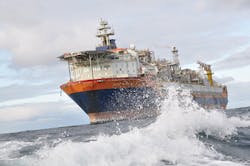Offshore Europe
Jeremy Beckman • London
Glendronach opens Shetlands play
Almost 200 exploratory wells have been drilled in UK waters over the past 10 years, according to Westwood. The analyst’s 2008-17 UK Offshore Exploration Performance report found that 117 companies had been involved targeting 26 plays and discovering 1.5 Bboe of commercial resources. Of these, 900 MMboe have since been sanctioned for development.
At peak, 32 wells were drilled across the sector in 2008, proving a total of 471 MMboe, while since the oil price fall in 2014 activity has stabilized at around 15 wells per year. The most active explorer during the period was Maersk Oil & Gas (since acquired by Total) drilling 20 wells and discovering the 250-MMboe Culzean field in the central North Sea. Otherwise, only BP and Dana Petroleum proved net resources of over 100 MMboe.
This year, although UK exploratory activity has been subdued, two commercial finds were reported by October led by Total’s 1-tcf Glendronach gas discovery west of Shetland in a formation below the Edradour field (a new syn-rift Cretaceous turbidite play). Total said it would pursue a swift development through the Laggan-Tormore subsea pipeline system. Kevin Swann, Wood Mackenzie’s senior research analyst, North Sea said the find could account for 10% of the UK’s gas during its early years of production.
Equinor to take on Rosebank
Another major west of Shetland project could finally go forward after Chevron agreed to sell its 40% operated interest in the Rosebank field to Equinor. Chevron discovered the field in 2004, close to the median line with the Faroe Islands in 1,100 m (3,609 ft) of water, the deepest for any UK find to date, with estimated recoverable reserves of over 300 MMboe.
However, the company has struggled to come up with an economic development solution despite sanctioning studies based on an FPSO, due partly to the water depth and the locally rough environment. It has also been clear that the North Sea area is no longer a strategic priority, having recently agreed to sell its 12% stake in the Danish Underground Consortium (DUC) responsible for much of Denmark’s production to Total.
Equinor had previously been a partner in Rosebank in its Statoil guise. The company’s UK Country Manager Al Cook said his company had “a proven track record of high value field developments across the North Sea.” Wood Mac’s Swann pointed to the company’s recent success in re-scoping another high-cost, harsh-environment project, Johan Castberg in the Barents Sea.
Siccar Point Energy has appointed Crondall Energy to assess FPSO options for the Cambo oilfield, 30 km (18.6 mi) southwest of Rosebank following a successful recent well test. The field, proven by Hess in 2002, is thought to hold in-place reserves of 600 MMbbl. Five wells have been drilled and the latest, which concludes the appraisal phase, has been suspended and will be incorporated into the field development plan. In addition, Crondall is working on pre-FEED technical assurance studies for the subsea facilities.
Shell’s 30% farm-in to Cambo has galvanized the project, and the company has also sanctioned a second subsea tieback this year through its Shearwater HP/HT gas/condensate production complex in the UK central North Sea. The Arran field, discovered in 1985, will be tied in via four wells exporting 21,000 boe/d and a new 50.4-km (31 mi) pipeline to the Shearwater platform. In June, Shell committed to a tieback of the Fram field (12,400 boe/d) via another new pipeline to the Starling satellite and existing infrastructure connected to the platform.
However, the company has followed Chevron’s lead in exiting upstream operations in the Danish North Sea, agreeing to sell its 36.8% share in the DUC to Altinex, a subsidiary of Norwegian independent Noreco, for $1.9 billion.
Cape Vulture set for Norne tieback
Appraisal drilling has finished of the 2017 Cape Vulture oil discovery off the Nordland Coast in the Norwegian Sea. Operator Equinor assesses recoverable resources at 50-70 MMbbl: this is more than twice the remaining oil due to be produced through the Norne field FPSO, 7 km (4.3 mi) to the southeast, which would probably host the development.
The Norne FPSO. (Photo Anne-Mette Fjoerli, courtesy Equinor)
Norne came onstream in 1997 and through progressive exploration and satellite tie-ins in the area, the company has managed to sustain economic production. Cape Vulture, which will likely extend the life of the facilities beyond 2030, has also proven a new play in the Nordland Ridge area – Equinor plans a well on another prospect in the region next year.
This is a period of intense development activity for the company across the Norwegian sector and will partly balance the books by selling its 77.8% interest in the King Lear gas/condensate discovery in the southern Norwegian North Sea to Aker BP for $250 million. Aker BP sees potential for a tieback to its Ula complex 50 km (31 mi) to the north, also providing extra volumes of gas to support increased oil recovery from Ula. If the project goes ahead, it could represent net resources to the company of over 100 MMboe.


